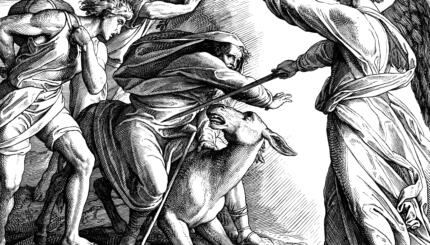Commentary on Parashat Nasso, Numbers 4:21 - 7:89
This week’s Torah portion continues to discuss the arrangements for the trek the Jewish nation is about to make through the desert to the Land of Israel. The Levites, who are responsible for transporting the Tabernacle, are counted, and their work-load is apportioned among them. This is followed by a number of laws concerning ritual purity, aimed at keeping the encampment pure, and a number of other laws whose placement here seems odd and which I will not talk about.
Then, towards the end of the portion, after everything seems to have been arranged, and the nation should be ready to start to make its way to the promised land, with the Tabernacle in place at the center of the camp and all the tribes arranged appropriately around it as they travel through the desert, the nesi’im, the leaders of the twelve tribes, suddenly approach Moses.
They bring him a gift — “six covered wagons and twelve cattle, a wagon for every two leaders and an ox for each one, and they brought them near to the Tabernacle.” Moses is unsure what to do with this voluntary gift, until God tells him: “Take these from them, that they may be for the work of the Tent of Meeting, and give them to the Levites, each man according to his work-load.” Moses then apportioned the wagons and oxen among the Levites, according to the amount of material from the Tabernacle that they had to transport.
A Voluntary Gift
This voluntary, spontaneous gift to the Levites on the part of the heads of the tribes contains many interesting messages. First of all, we have the theme of the Torah’s ‘leaving space.’ After dozens, no, hundreds, of verses relating to the way the Tabernacle should be designed, constructed and transported, there was still room left for improvement–still room for a new, innovative technological (!) way to make the work of transporting the parts of the Tabernacle easier and more efficient.
This is not the only occasion on which the Torah seems to leave space in this way for suggestions, improvements, challenges, or changes to the orders handed down by God to the people through Moses. In an interesting parallel, Rashi points out that the heads of the 12 tribes, as leaders, also ‘left space’ for the Jewish people, the people they were leading, in which to act. Rashi explains that all through the process of donating materials for the Tabernacle — the silver, gold, fabrics, and other materials needed — the nesi’im are not mentioned. This is because they did not, as nesi’im, bring any specific donations. Instead, Rashi tells us, they held back, leaving room for the people to act first and bring what they could, thinking that they, the leaders, would fill in later whatever was missing.
They were surprised that the people brought as much as they did; at the end of the process there was very little left for them to donate. This, according to Rashi, is the reason why they hurried to bring the gifts of the wagons and oxen; to fill a gap that they perceived, before one of the people did. The nesi’im wanted this opportunity, which, until now, because of their leadership style, they had not had, to bring something of their own for the Tabernacle.
This model of leadership, wherein those in charge leave room for their ‘followers’ to act, and see themselves as being there only to do whatever is left undone, is a fascinating one. I have often thought about parenting in this way–the challenge is to leave space for your kids to do the right thing on their own. The Jewish people, at this early sage of their nationhood, were getting some very good parenting.
A former teacher of mine, Rabbi Jay Miller, once compared the Ari’s (16th century Safed) Kabbalistic model of the creation of the world to parenting. God has to do an act of tzimtzum–shrinking, contracting–in order to make room for something other than himself to exist–that something being the created universe. Parents, too, must do an act of tzimtzum in order to leave space for their children to function and grow. The difficulty that the nesi’im had with this, when they saw that their ‘children’, the people of Israel, had gone ahead and done just about everything for themselves, leaving them to scramble to try and find some area where thy could make a contribution, is interesting and beautiful.
There is also the theme of egalitarianism, and brotherhood. The Levites are assisted in their role in the Tabernacle by the rest of the people; the nesi’im, representing their tribes, act sensitively, and in harmony, to make the Levites’ work easier. In this way, the entire nation has an ongoing stake in the day-to-day functioning of God’s Temple. The S’forno (15th-16th century Italy) also points out that having every two nesi’im give one ox is another sign of cooperation and brotherhood.
After this section, the nesi’im again approach Moses, with yet another voluntary gift. Each one of the 12 nesi’im brings a series of animal and vegetable sacrifices to be offered on the altar, along with vessels that they donate to the Tabernacle. Once again, Moses is nonplussed, until God gives him the go-ahead, and orders each one of the nesi’im to bring his sacrifice separately, one day at a time. What is the purpose of this second round of unbidden gifts? Why did the nesi’im bring them? What need do they serve, what hitherto un-thought role do they play?
Rashi’s Explanation
Rashi has a beautiful explanation: “After they offered the wagons and cattle used to transport the Tabernacle, their hearts moved them to volunteer these sacrifices to dedicate the altar.” The language Rashi uses is highly suggestive. If their first batch of giving — the wagons and the oxen — was essentially a response to a real need that the Levites had, this second round is an answer to an inner need on the part of the nesi’im to give. The nesi’im inspired themselves: they were moved by their unselfish, creative, sensitive and brotherly act of giving to give more.
Moses was at first unsure of how to respond to this. God’s response–let them bring the sacrifices, one day at a time–seems to not only accept the spontaneous gift of each nasi, but to spotlight it, individualize it. God’s decision to give each nasi a separate day in which to bring his sacrifice seems to underscore the individuality of each gift. This, in spite of the fact that they all gave the exact same thing.
The Torah, in fact, at the very end of our portion, goes through the same list, twelve times, of animals and incense and grain offerings and utensils that each one of the leaders brought. This seemingly unnecessary repetition of the same list of offerings creates, I think, a balance. A balance between the individual expression of each nasi’s desire to give of himself to the Tabernacle — underscored by each nasi getting his own day and his own separate mention–and the collective nature of their act — they all originally approached Moses together and they all give the exact same thing.
This balance between the individual and the collective, between the urge to stand out from and the urge to be a part of, is a balance that all of us must struggle to achieve in our personal and communal lives.
Provided by the Bronfman Youth Fellowships in Israel, a summer seminar in Israel that aims to create a multi-denominational cadre of young Jewish leaders.
Torah
Pronunced: TORE-uh, Origin: Hebrew, the Five Books of Moses.



